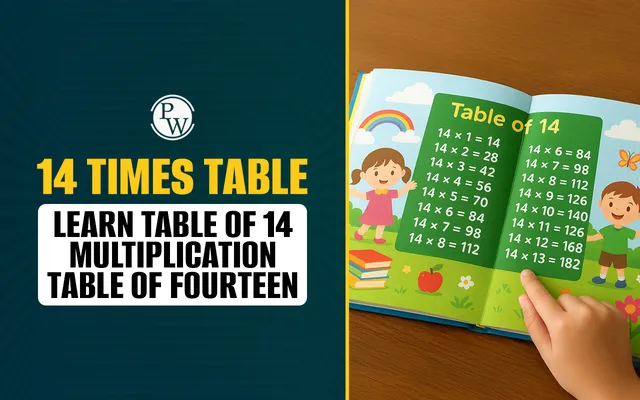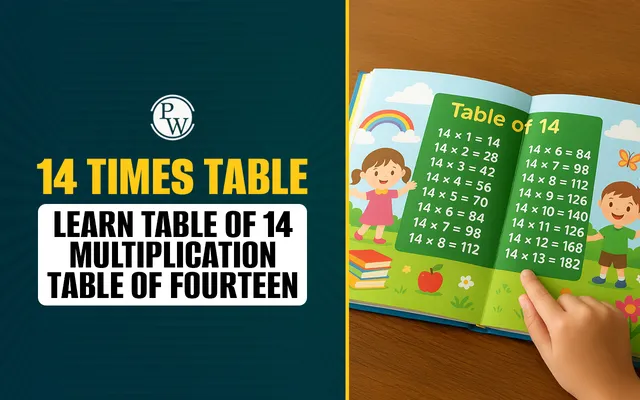

14 Times Table
The 14 times table is a multiplication sequence where each number is multiplied by 14. Learning the multiplication table of 14 helps students solve math problems faster, strengthens arithmetic skills, and builds confidence in handling larger numbers.
Multiplication tables form the backbone of mathematics. They simplify calculations, enhance number sense, and prepare students for advanced topics like algebra, fractions, and geometry. Among these, the 14 times table plays a vital role in helping learners understand higher multiples and large number sequences.
Mastering the 14 times table not only improves mental math speed but also builds confidence in solving division, multiplication, and real-life arithmetic problems. Students should learn everything about the 14 times table, including a 14 times table chart, detailed multiplication table of 14, useful tips for learning it, and more below.
Read More: Tables 1 to 10
14 Times Table Chart
A 14 times table chart is a visual tool that helps learners quickly memorize and recognize patterns in multiples of 14. Using a chart allows students to see the relationships between numbers, making it easier to recall answers during calculations. The table below includes 14 times table chart for reference:
|
14 Times Table Chart |
|
|
14 × 1 |
14 |
|
14 × 2 |
28 |
|
14 × 3 |
42 |
|
14 × 4 |
56 |
|
14 × 5 |
70 |
|
14 × 6 |
84 |
|
14 × 7 |
98 |
|
14 × 8 |
112 |
|
14 × 9 |
126 |
|
14 × 10 |
140 |
Using the 14 times table chart regularly reinforces memorization, and it also allows learners to recognize patterns in multiples, such as consistent increments and repeated last digits.
Multiplication Table of 14
The multiplication table of 14 is simply a sequence of numbers obtained by multiplying 14 with natural numbers. Each number in this table is a multiple of 14, which helps students understand how multiplication works with larger numbers.
The following are some additional examples of the 14 times table:
-
14 × 11 = 154
-
14 × 12 = 168
-
14 × 13 = 182
-
14 × 14 = 196
-
14 × 15 = 210
Patterns in the 14 Times Table:
-
Even Numbers: Every product in the multiplication table of 14 is an even number since 14 itself is even.
-
Repeating Last Digits: The last digits of multiples of 14 follow a repeating cycle: 4, 8, 2, 6, 0.
-
Incremental Growth: Each consecutive multiple increases by 14, which makes it predictable and easier to learn.
-
Derived from 7 Times Table: The 14 times table is twice the 7 times table (e.g., 7 × 3 = 21 → 14 × 3 = 42), which can be helpful for quicker memorization.
Read More: Table of 11
Tips to Remember 14 Times Table
Memorizing the 14 times table can seem challenging at first, but with the right strategies, it becomes much easier. Following are some effective tips for 14 times table:
-
Break into Smaller Tables: Since 14 is double 7, use the 7 times table to simplify learning. For example, 7 × 4 = 28, so 14 × 4 = 56.
-
Use Addition: Start from 14 and keep adding 14 to get the next multiples: 14, 28, 42, 56…
-
Spot Patterns: Observe the last digit cycle (4, 8, 2, 6, 0) to predict results.
-
Practice with Real-Life Examples: Count items in groups of 14, such as eggs in cartons, chairs in rows, or packs of pencils.
-
Write and Recite: Repetition improves memory retention. Writing the 14 times table repeatedly helps strengthen recall.
-
Use Flashcards: Quick exercises with flashcards encourage faster mental calculations and make learning interactive.
-
Group Multiples Mentally: Group numbers into tens and units to simplify calculations (e.g., 14 × 12 = 14 × 10 + 14 × 2 = 140 + 28 = 168).
Boost Math Skills and Confidence with PW CuriousJr’s Mental Maths Course
PW CuriousJr’s Mental Maths Course is designed to help students improve their speed, accuracy, and confidence in mathematics. The lessons are easy to follow and focus on solving problems in the mind, making math less stressful and more enjoyable. Students build comfort with numbers while practicing real-life calculations.
Key Features
-
Strengthen basic math skills including addition, subtraction, multiplication, and division
-
Improve speed and accuracy to solve problems quickly
-
Engage in hands-on activities and regular practice to boost mental math skills
-
Simple, student-friendly lessons that make learning fun and stress-free
This course is ideal for school students who want to sharpen everyday math skills, become more confident with numbers, and enjoy learning in a supportive and interactive environment.
